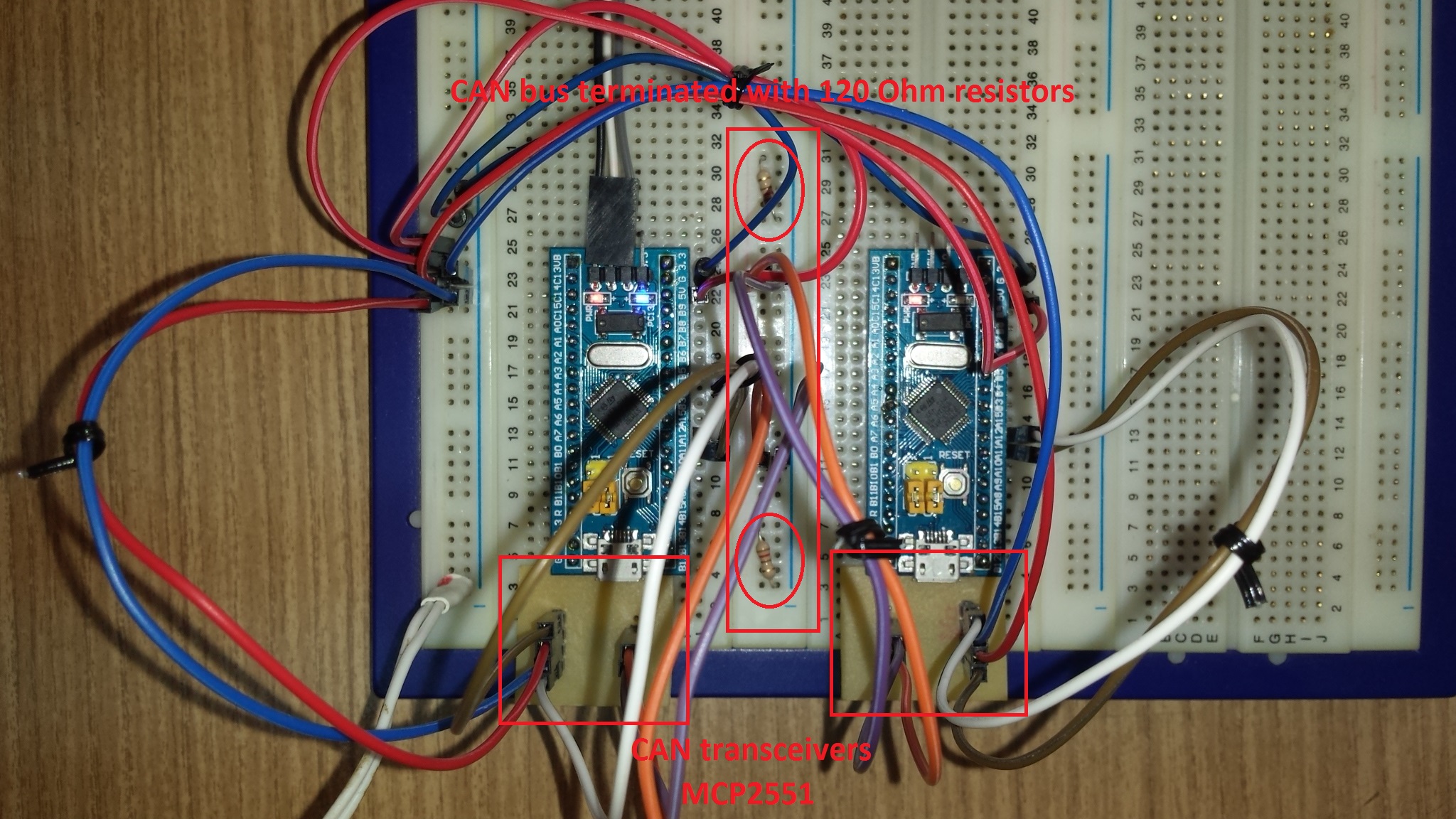Using CAN bus with (not just NUCLEO) mbed boards
Using CAN bus with mbed boards
Two low cost STM32F103C8T6 boards are connected to the same CAN bus via transceivers (MCP2551 or TJA1040, or etc.). CAN transceivers are not part of NUCLEO boards, therefore must be added by us. Remember also that CAN bus (even a short one) must be terminated with 120 Ohm resitors at both ends. Although there seems to be an alternative solution.
Schematic

Hookup

The mbed boards in this example are transmitting CAN messages carrying two data items:
uint8_t counter; // one byte float voltage; // four bytes
So in this case the total length of payload data is five bytes (must not exceed eight bytes).
For our convenience, the "<<" (append) operator (defined in CANMsg library) is used to add data to the CAN message.
The usage of "<<" and ">>" operators is similar to the C++ io-streams operators. We can append data one at a time
txMsg << counter; txMsg << voltage;
or combine all into one expression.
txMsg << counter << voltage;
The actual data length of a CAN message is automatically updated when using "<<" or ">>" operators.
After successful transmission the CAN message is printed to the serial terminal of the connected PC. So we can check the details (ID, type, format, length and raw data). If something goes wrong during transmission a "Transmission error" message is printed to the serial terminal.
On arrival of a CAN message it's also printed to the serial terminal of the connected PC. So we can see the details (ID, type, format, length and raw data). Then its ID is checked. If there is a match with the ID of awaited message then data is extracted from the CAN message (in the same sequence as it was appended before transmitting) using the ">>" (extract) operator one at a time
rxMsg >> counter; rxMsg >> voltage;
or all in one shot
rxMsg >> counter >> voltage;
The same source code is used for both boards, but:
- For board #1 compile the example without any change to main.cpp
- For board #2 comment out the line
#define BOARD1 1before compiling
Once binaries have been downloaded to the boards reset both board at the same time.
NOTE:
The code published here was written for the official NUCLEO boards. When using STM32F103C8T6 boards, shown in the picture above (on-board LED is active on 0),
- Include (uncomment) the line
#define TARGET_STM32F103C8T6 1 - Select NUCLEO-F103RB as target platform for the online compiler.
CAN bus related information
Diff: main.cpp
- Revision:
- 3:87a128bca8f5
- Parent:
- 2:6546e4a2d593
- Child:
- 4:09d564da0e24
--- a/main.cpp Wed Oct 11 16:29:04 2017 +0000
+++ b/main.cpp Thu Mar 29 18:57:18 2018 +0000
@@ -1,7 +1,7 @@
/*
* An example showing how to use the mbed CAN API:
*
- * Two affordable (less than $3 on ebay) STM32F103C8T6 boards (20kB SRAM, 64kB Flash),
+ * Two affordable (about $2 on ebay) STM32F103C8T6 boards (20kB SRAM, 64kB Flash),
* (see [https://developer.mbed.org/users/hudakz/code/STM32F103C8T6_Hello/] for more details)
* are connected to the same CAN bus via transceivers (MCP2551 or TJA1040, or etc.).
* CAN transceivers are not part of NUCLEO boards, therefore must be added by you.
@@ -13,9 +13,9 @@
*
* The same code is used for both mbed boards, but:
* For board #1 compile the example without any change.
- * For board #2 comment out line 23 before compiling
+ * For board #2 comment out line 21 before compiling
*
- * Once the binaries have been downloaded to the boards reset board #1.
+ * Once the binaries have been downloaded to the boards reset both boards at the same time.
*
*/
#define BOARD1 1 // comment out this line when compiling for board #2
@@ -42,8 +42,8 @@
#include "mbed.h"
#include "CANMsg.h"
-Serial pc(PA_2, PA_3);
-CAN can(PA_11, PA_12); // CAN Rx pin name, CAN Tx pin name
+Serial pc(USBTX, USBRX);
+CAN can(p30, p29); // CAN Rx pin name, CAN Tx pin name
CANMsg rxMsg;
CANMsg txMsg;
DigitalOut led(LED_PIN);
@@ -56,7 +56,7 @@
* @brief Prints CAN msg to PC's serial terminal
* @note
* @param CANMessage to print
- * @retval none
+ * @retval
*/
void printMsg(CANMessage& msg) {
pc.printf(" ID = 0x%.3x\r\n", msg.id);
@@ -91,16 +91,16 @@
pc.printf("CAN_Hello board #2\r\n");
#endif
while(1) {
- if(timer.read_ms() >= 1000) { // check for timeout
- timer.stop(); // stop timer
- timer.reset(); // reset timer
- counter++; // increment counter
- voltage = (analogIn * 3.3f) / 4096.0f; // read the small drifting voltage from analog input
- txMsg.clear(); // clear Tx message storage
- txMsg.id = TX_ID; // set ID
- txMsg << counter << voltage;// append data (total data length must be <= 8 bytes!)
- if(can.write(txMsg)) { // transmit message
- led = OFF; // turn the LED off
+ if(timer.read_ms() >= 1000) { // check for timeout
+ timer.stop(); // stop timer
+ timer.reset(); // reset timer
+ counter++; // increment counter
+ voltage = analogIn * 3.3f; // read the small drifting voltage from analog input
+ txMsg.clear(); // clear Tx message storage
+ txMsg.id = TX_ID; // set ID
+ txMsg << counter << voltage; // append data (total data length must not exceed 8 bytes!)
+ if(can.write(txMsg)) { // transmit message
+ led = OFF; // turn the LED off
pc.printf("-------------------------------------\r\n");
pc.printf("CAN message sent\r\n");
printMsg(txMsg);